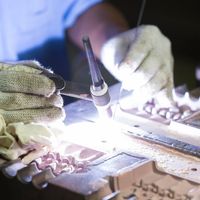 Small manufacturers today face pressure to produce high-quality parts with tighter tolerances, faster turnaround times, and greater customization. To stay competitive, many are turning to micro-TIG welding—a precision welding method designed for tiny components and delicate materials. Once used primarily by large aerospace and medical companies, it has now become accessible and valuable for small shops as well.
Small manufacturers today face pressure to produce high-quality parts with tighter tolerances, faster turnaround times, and greater customization. To stay competitive, many are turning to micro-TIG welding—a precision welding method designed for tiny components and delicate materials. Once used primarily by large aerospace and medical companies, it has now become accessible and valuable for small shops as well.
1. The Push Toward Miniaturization
Industries like electronics, automotive, medical devices, and consumer products are shrinking component sizes year after year. Even small manufacturing businesses now handle:
-
Compact enclosures
-
Fine metal contacts
-
Miniature mechanical parts
-
Micro-tools and instrumentation
Micro-TIG welding gives small manufacturers the ability to handle this shift by enabling controlled, pinpoint metal joining at extremely small scales.
2. Cost-Effective Precision Without Large Equipment
Traditional precision welding setups can be large, expensive, and resource-heavy. Micro-TIG systems are:
-
More compact
-
Less costly than full-scale industrial welding stations
-
Easier to integrate into existing workspaces
This lowers the barrier of entry and makes advanced welding capabilities attainable for smaller operations.
3. Expanding Capabilities Without Outsourcing
Small manufacturers often rely on outside vendors for delicate repairs or miniature welding. By bringing micro-TIG welding in-house, companies can:
-
Reduce lead times
-
Avoid outsourcing costs
-
Increase control over scheduling and quality
This is especially useful for repairs on molds, dies, small fixtures, and detailed components.
4. Highly Localized Heat for Delicate Parts
Many small shops work with thin metals or tiny components that can be easily damaged by broad heating. Micro-TIG welding uses very localized heat zones, which helps:
-
Protect sensitive edges and features
-
Maintain dimensional accuracy
-
Support repairs or additions to fragile areas
This makes the process suitable for industries that need fine detail work without compromising the surrounding material.
5. Ideal for Custom Jobs and Low-Volume Work
Smaller manufacturers often take on:
-
Custom fabrications
-
Short runs
-
Prototyping
-
One-off repairs
Micro-TIG welding is flexible and adaptable, making it a strong fit for these variable, small-batch workflows.
6. Improved Tooling and Mold Repair
Micro-TIG welding is widely used in mold and die maintenance—a major area where small manufacturers lose time and money. It allows for extremely targeted metal addition on worn areas, supporting:
-
Extended mold life
-
Reduced downtime
-
More economical tooling maintenance
This is especially valuable for shops with tight margins.
7. Competitive Advantage in Niche Markets
Small manufacturers specializing in fields like jewelry, dental tools, electronics, and fine mechanical parts can use micro-TIG welding to differentiate themselves.
It helps them offer:
-
Finer detail work
-
More accurate repairs
-
Stronger micro-scale joints
-
Services larger shops may not provide
This positions them as precision-capable suppliers in high-value niches.
Conclusion
Small manufacturers are adopting micro-TIG welding because it offers precision, flexibility, cost savings, and the ability to work on miniature components—all without requiring massive, industrial-scale equipment. As industries continue to shrink their designs and demand higher accuracy, micro-TIG welding gives smaller shops the tools to stay competitive, expand their capabilities, and deliver high-quality results.

